On December 10, 1952, "Columbia Pictures" distributed an independently made motion picture from "American Pictures Corporation". The title was "Invasion U.S.A." and this "B" movie brought to life the fear of a Soviet Invasion of the United States.

Gerald Mohr, 1959's "Angry Red Planet", was television anchorman "Vince Potter". Peggie Castle, 1957's "Beginning of the End", was New York socialite "Carla Sanford" and Dan O'Herlihy, 1984's "The Last Starfighter", was the mysterious "Mr. Ohman". These three people and an Arizona Rancher, a Congressman and a California Industrialist are strangers in bar together, but in many ways they represented the average American viewing "Invasion U.S.A.".
Suddenly, on the bar's television, a breaking news report about the, implied but not named, Soviet Union dropping an Atomic Bomb upon a United States military base in Alaska. The six people and the bar tender are stunned. Shortly, the first report is followed by an additional story about another Atomic Bomb drop and paratroops beginning to land in major American cities.
The "Red Scare" screenplay by Franz Schultz as Franz Spencer brought to life the fear of many Americans at the time. The film wasn't very subtle, but in the World I lived in at six years old. Drop and cover drills in school were daily. As where Civil Defense Siren Tests and Government warnings that your neighbors might be Communist agents. This small feature film was very effective and well acted.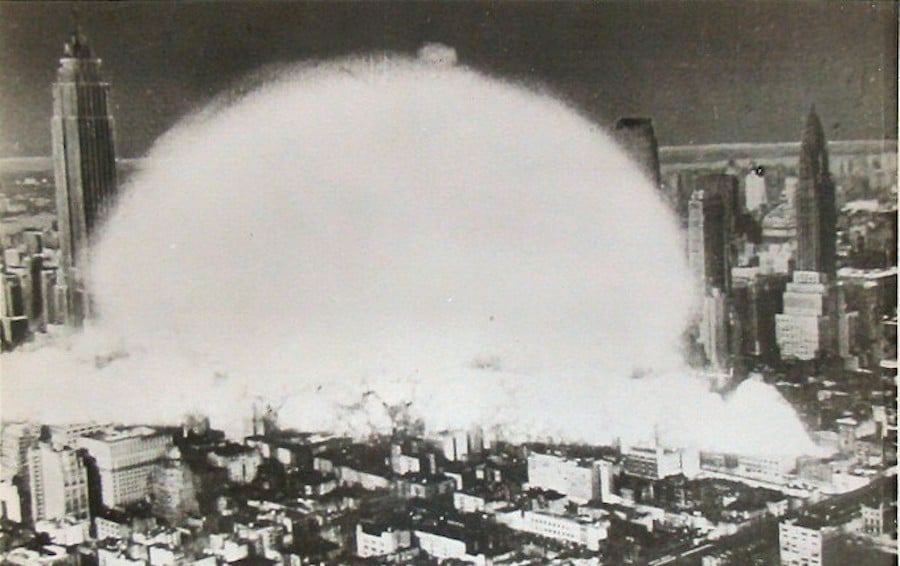
The "Second Red Scare", the first followed World War One and at that time was a fear that Union's were really Communist fronts, was a widespread fear in the United States of the potential rise of Communism since the end of the Second World War. At one point it took on the name of Senator Joseph McCarthy and reached into the motion picture industry in the form of "Black Listings". That resulted from the fear of, or being questioned by, the "House Committee on Un-American Activities".
In 1947 three ex-FBI agents started publishing "Counterattack". Which was nothing more than an ever enlarging list of names of people within the motion picture industry and radio. The published names, mostly without evidence, were said to be members of the Communist Party and the three agents demanded they all be fired.
Major Radio and Television star Ed Sullivan, "Toast of the Town" aka: "The Ed Sullivan Show", used "Counterattack" to screen his potential guests and, if their name was on the list. Then he wouldn't permit them, no matter how famous, on his show. 
From October 1, 1953 to January 1, 1956 was a very popular television program "I Led 3 Lives". It was based upon the bestselling book by Herbert A. Philbrick and starred Richard Carlson. The real Philbrick was a Boston advertising executive and typical 1950's family man. However, his second life was as a member of the Communist party, but his third life was that he worked for the FBI to take down Communist cells.
In 1952 Gary Cooper and Grace Kelly starred in the Western "High Noon". The picture was extremely popular and won four Oscars from the "Academy of Motion Picture Arts and Sciences". Carl Foreman was nominated for his screenplay.
It is that screenplay that has remained controversial to this day and was the last motion picture screenplay Carl Foreman was permitted, by the "House Committee on Un-American Activities" and the American Motion Picture industry, to write in the United States in 1953.
Carl Foreman was "Blacklisted' and labeled an "uncooperative witness" for refusing to name names of possible Communists and answer the committee's questions. He never admitted to being a Communist, but was considered a sympathizer. Upon the Committee's finding, Foreman's business partner, producer Stanley Kramer, demanded an immediate dissolving of their partnership.
Carl Foreman left the country for the United Kingdom. Where, the "American State Department" required him to report to the American Council and turn in his passport. In 1957 Foreman and another "Black Listed" writer, Michael Wilson, wrote the screenplay for director-producer David Lean's "The Bridge on the River Kwai". Neither man's name appears on-screen and were replaced by the author of the novel Pierre Boulle. The screenplay won the "Academy Award" and the non-English speaking Boulle accepted "HIS" Oscar. Carl Foreman was finally permitted back into the United States in 1975.
Sometimes a motion picture seems to be one thing, but is in reality something else.
From the day of the pictures release. There was a belief that Carl Foreman's screenplay for "High Noon" was an allegory on McCarthyism. Director Fred Zinnemann denied that story. As did producer Stanley Kramer, but many film historians believe otherwise.
I've mention all of this, because, possibly like "High Noon", there were also other motion pictures that seemed anything but "Red Scare" related. However, they had underlining messages that played to American fears of the 1950's. This is a look at three such Science Fiction films.
The first and third motion pictures reflect a major fear, generated by the Government, that your next door neighbor might be, in reality, a "Communist Agent". While, the second motion picture tweaks the concept.

Related to the above newspaper advertisement was the term "Iron Curtain". It had been created by England's Prime Minister Winston Churchill. "Iron Curtain" was described to 1950's American's as "General Secretary of the Communist Party of the Soviet Union" Joseph Vissarionovich Stalin's attempt to remove Russia and its "Satellite States" from any contact with the "West" and other European countries. Even in my elementary school we were told that the people living "Behind the Iron Curtain" had no free will and had to obey the Communist Party. 

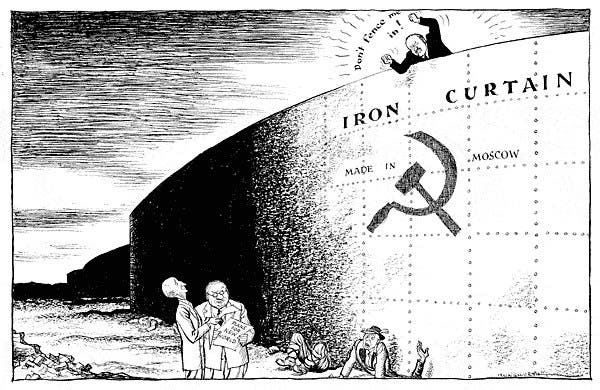
Now for the three motion pictures I want to speak about:
INVADERS FROM MARS released April 9, 1953
The motion picture came from the independent motion picture company "National Pictures Corporation". I could not locate any information about them, but as the final film was released by "20th Century Fox". It is possible that "National Pictures Corporation" was a "B" film subsidiary of the larger company. "Invaders from Mars" was shot at one of the "Republic Pictures" movie ranches.
The credited screenplay was the sixth of eight written by Richard Blake. He was a former editorial writer for "The Cincinnati Times-Star". There's no other information about him that I could locate, but as an editorial writer. Richard Blake had to be opinionated. There was a non-on-screen credited writer John Tucker Battle, if you credited his television screenplays. Then Battle wrote 31 and they included six other feature films. I also could not locate any other material about him.
The motion picture is still down-right nightmarish and has scary tone. This came from the man who actually made the feature film. Director, Production Designer and Art Director William Cameron Menzies. Below Menzies on the set of the movie.
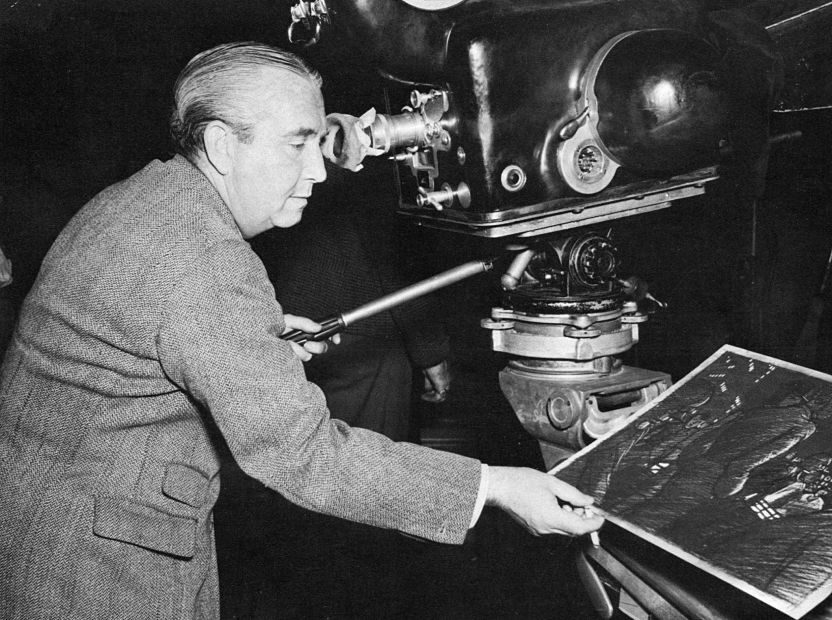
In 1939 it was without on-screen-credit that William Cameron Menzies burned down Atlanta in "Gone With the Wind". Three years earlier he directed the classic Science Fiction "Things to Come" from a screenplay actually written by H.G. Wells and directed Bela Lugosi as "Chandu the Magician" in 1932. In 1943, Menzies was the Production Designer for the Gary Cooper and Ingrid Bergman version of Ernest Hemingway's "For Whom the Bells Toll".
The Six Main Cast Members By Billing:
Helena Carter portrayed "Dr. Pat Blake". This was her thirteenth and final motion picture. She decided a motion career wasn't for her.
Arthur Franz portrayed "Dr. Stuart Kelston". In 1951, Franz took a "Flight to Mars" and was the "Invisible Man" for Abbott and Costello. While in 1958 he was the "Monster on the Campus", but back in 1954 was one of the Naval Officers putting up with Humphrey Bogart in "The Caine Mutiny".
Jimmy Hunt portrayed "David MacLean". Prior to this feature Hunt appeared in thirty-three feature films with thirteen of those roles without on-screen credit. He would have a cameo as a "Police Chief
in Tobe Hooper's 1986 remake of "Invaders from Mars".

Above left to right, Arthur Franz, Jimmy Hunt and Helena Carter.
Leif Erickson portrayed "Mr. George MacLean". From 1967 through 1971 Erickson starred on television's "The High Chaparral", but before that he was seen in 1964's "The Carpetbaggers", 1954's "On the Waterfront", William Castle's 1949 "Johnny Stool Pigeon" and the Bela Lugosi and Lionel Atwill low budget 1942 Horror film "Night Monster".
Hilary Brooke portrayed "Mrs. Mary MacLean". From 1952 through 1953 she portrayed a character with the original name of "Hillary Brooke" on the Abbott and Costello television show. Her other feature films include co-starring in the 1941 "The Lone Ranger Rides Again" and "The Lone Ranger in Frontier Fury". Brooke appeared in two of the Basil Rathbone and Nigel Bruce "Sherlock Holmes" series, 1942's "Sherlock Holmes and the Voice of Terror" and 1943's "Sherlock Holmes Faces Death".
Above Hilary Brooke and Leif Erickson.
Morris Ankrum portrayed "Colonel Fielding". Ankrum would become a face very familiar to 1950's Science Fiction fans. My article "MORRIS ANKRUM THE FACE OF 1950'S SCIENCE FICTION/HORROR MOVIES" can be read at:
http://www.bewaretheblog.com/2016/02/morris-ankrum-face-of-classic-1950s.html
Above Morris Ankrum on the phone and Max Wagner as "Sergeant Rinaldi".
Before I go any further, I want to address the controversy that "Invaders from Mars" might have been filmed in a Three-Dimension Process, but not released in that format.
The argument against 3-D seems to rest on one fact only! As mentioned in Bill Warren's "Keep Watching the Skies", Volume One, 1982. As "Invaders from Mars" was in actual production at the same time the "First Commercial 3-D" picture, "Bwana Devil" was released on November 26, 1952. William Cameron Menzies picture could not have been shot in the 3-D process, if accurate that is a strange argument to make.
The following still is of just one of several audiences watching three 3-D short movies at 1951's "Festival of Britain". The pictures, "A Solid Explanation", "Royal River" and "The Black Swan" were shot in a dual strip 3-D process filmed by Raymond Spottiswoode

My point is simply that the technology was a known quantity, but what process you used might not be the same. Arch Obler's "Bwana Devil", also used a dual strip process to create the 3-D called "Natural Vision". That process was invented and owned by M.L. Gunzberg and projected onto a movie screen with Polaroid Filtered Projectors.
Another point of consideration was that William Cameron Menzies next motion picture was "The Maze", released on June 24, 1953, and shot in 3-D. Initially, that feature was planned to have been his SECOND 3-D motion picture. Again, adding to the story that "Invaders from Mars" was to have been shot in 3-D. Additionally the style used for the opening titles doesn't help the argument that the picture wasn't shot in 3-D, but not released in it.
It should be noted that there was no other William Cameron Menzies feature that could have been considered as his "First 3-D Motion Picture", because prior to "Invaders from Mars". He directed a 1952 made for television 26 minute film entitled "The Adventures of Fu Manchu: The Zayat Kiss". The short film starred John Carradine as "Fu Manchu" and Sir Cedric Hardwicke as "Dr. Dennis Nayland Smith" of Scotland Yard. After the release of "The Maze" Menzies directed eighteen episodes of the 1954 television series "The Halls of Ivy" in sequence and two other 1954television programs.
What does is all have to do with the theme of this article? William Cameron Menzies was not only the film's director, but designed the production. Which meant his sets and their visuals help create the tone. In some cases the sets and angle of the shots appear to be designed with a foreground, middle ground and background, as you would have shooting in the Third-Dimension.
Menzies sets, in many instances, seemed inspired by the production designs of Walter Reimann, Walter Rohrig and Herman Warm for the German 1919 "The Cabinet of Dr. Caligari".
Above "The Cabinet of Dr. Caligari" and below "Invaders from Mars".
William Cameron Menzies is using that same nightmarish concept throughout the picture to subtlety influence his viewing audience. He shoots scenes from odd angles and creates unnatural images accented by his sparse use of props. One famous setting is the inside of the Police Station with its weird long hall and angels of the shots from above and below.
Looking at the Screenplay:
The audience meets a typical 1950's family with two loving parents "George" and "Mary MacLean" and their fifteen years old son "David". Who is a science enthusiast taking after his father. The viewer sees "David" using his telescope, first with his father to look at the planet Mars and later on his own.
"David" is awaken by both a terrible storm and a strange noise. Going to his window he sees what looks like a flying saucer land in the Sand Pit near their rural home and goes to tell his father about it.

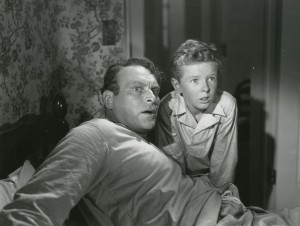
His father is convinced to go investigate, if only to calm his son's fears. However, there may be another motive not stated.
So far we have a typical Science Fiction feature film opening. I now direct my reader back to the poster at the beginning of this section that you might not have really read. I give you the tag lines in three of the squares to the left of the picture's titles:
A General of the Army turned into a SABOTEUR!
Parents turned into...rabid KILLERS!
Trusted police become...ARSONISTS!
These are actual "Red Scare" concerns that were being projected by the American Government about the Communists. Along with the one about your neighbor possibly being Russian trained to infiltrate the country.
It's morning and "George MacLean" hasn't returned home to his very worried wife and son. Then he enters the house and is not the same man. The kind and loving "George" is now abusive to "Mary" and tells "David" to "Shut up and be quiet!". Then "David" notices an irritated "X" mark on his father's neck and "George" immediately pulls up his collar to cover it.

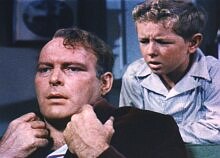

"David" hears the police officers mention a mission they have and "George MacLean" seems to acknowledge them.
Next, "David" is looking through his telescope and sees his neighbor's daughter "Kathy Wilson", played by Janine Perreau, disappear into the Sand Pit. He goes to "Kathy's" mother and tells her what he saw. This frightens the women believing that something has happened to her daughter, but "Kathy" appears. "David" is told he shouldn't be telling such stories and "Mrs. Wilson" will be calling his parents. However, "David" sees the same almost emotionless appearance on the girl's face that his father has now, but misses her chilling smile.

Meanwhile, "George MacLean" takes his wife to the Sand Pit.

"Dr. Pat Blake", of the Health Department, arrives and is brought to "David's" cell. He asks to take a look at the back of her neck and as strange as the request is shows him. He then explains what's happening and seeming to realize "David" is telling her the truth. "Dr. Pat Blake" decides to help him.

"David's" parents now arrive at the police station and want to take their son with them, but "Dr. Blake" tells the desk sergeant that he has a very major illness and requires hospitalization. The parents leave having been outmaneuvered.

"Dr. Blake" now takes "David" not to a hospital, but to see the local astronomer "Dr. Stuart Kelton" at the observatory.

"Dr. Kelston" becomes very concerned when he learns who "David's" father is and shows the other two the top secret rocket program "George MacLean" is working upon.

Since the end of World War Two, American's were seeing anti-Communist propaganda on the motion picture screens. Two examples, from 1949 America, are the "B" movies "The Red Menace". About an ex-GI becoming involved with the "Communist Party U.S.A.". He falls in love with one of his instructors teaching him the goodness of Communism. While, "I Married a Communist" aka: "The Women on Pier 13" starred Robert Ryan and Laraine Day. The two become involved with a "Communist Cell" after military secrets.
Below is an actual 1950 newspaper ad warning about Communists in the Motion Picture Industry and on Radio and Television. It gives my reader a real sense of the America that bred "McCarthyism".
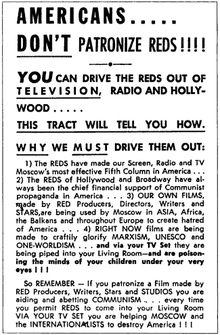
Another "B" Picture came from a major studio, Warner Brothers, in 1951 starring Frank Lovejoy. It was based upon a series of articles in "The Saturday Evening Post" about an actual FBI Operation against Communists recruiting American's.

Returning to "David", "Dr. Blake", "Dr. Kelston" looking at the revealed top secret government rocket project. The screenplay had "George and Mary MacLean", the two Police Officers, an Army General and even "Kathy Wilson", seeming to be working in, recognizable to the 1953 audience, a "Communist Cell".
In fact "George and Mary MacLean" could easily have been substitutes for Julius and Ethel Rosenberg. Who were convicted of espionage on behalf of the Soviet Union and were executed in Sing-Sing Prison on June 19, 1953. Only two months after the release of "Invaders from Mars".
As had been reported in the newspapers, on radio and television news. The Rosenberg's appeared to be a typical "Ozzie and Harriet" American family of four. When they were executed, Julius was 35 and had been an electrical engineer. While Ethel was 37 and during her life had been a "B" actress, singer and her husbands secretary. They had two young sons Michael and Robert.
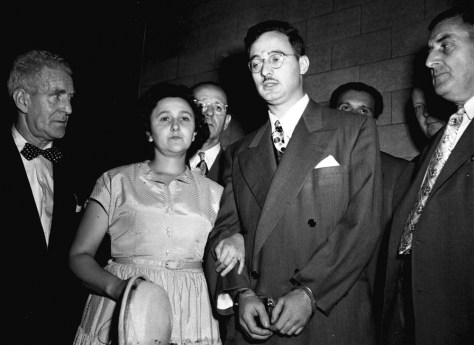
Above Ethel and Julius Rosenberg in custody of the FBI.
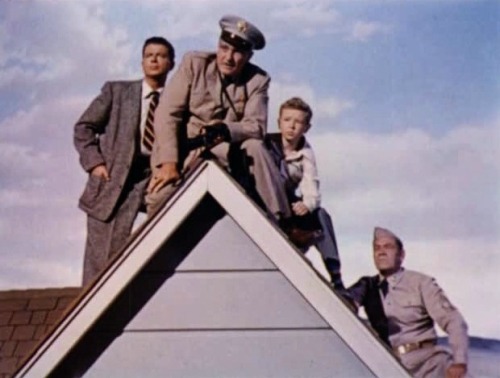
"Sergeant Rinaldi" gets off the roof and goes to take a closer look at the Sand Pit. Suddenly the sand opens up beneath him and he is pulled down firing his rifle at something he sees.


"Colonel Fielding" calls for local and military assistance and is now convinced that enemy agents have infiltrated the rocket project and are planning to destroy it.

Meanwhile, "Kathy Wilson" suddenly dies from a brain hemorrhage. An autopsy of her body reveals a control device of unknown technology placed within the brain stem at her neck.

Upon seeing this, "David" expresses concern for the lives of his parents.
The audience next sees U.S. Army "General Mayberry", played by William Forrest, and his aide stealing a highly classified explosive and placing it in a briefcase.
A very real "Red Scare Fear", at the time, was of Communist Agents turning members of the American military to their use.This would become the reality of the famous "Hollow Nickel FBI Case" and was part of the spy network built by Russian Rudolf Abel in 1948 that lasted until 1957.
Refusing to stop an army guard opens fire on "General Mulberry" and hitting the case blows the two men up.


"George" and "Mary MacLean" have driven onto the actual rocket project and to destroy the craft.

However, instead of accomplishing their mission. Their car crashes into a wall during a fire fight and they burn to death in it.
It is now time to confront the "Invaders from Mars". The area round the Sand Pit is encircled and a search for a way in is begun.
However, when no one is looking at them. "Dr. Blake" and "David" are sucked into the Martian caves below and the audience meets the green Martian humanoid slaves of "The Martian Intelligence". They do not speak, but act as directed by the "Intelligence". The same way American's have been told Communist Police and Military work.

"Dr. Blake" and "David" meet "Sergeant Rinaldi" a slave of the Martian Intelligence, because of the control device in his neck.

Next "David" and "Dr. Blake" are introduced to the "Martian Intelligence" itself. An allegorical Joseph Stalin bent on taking over the United States, or just your usual Martian ruler?


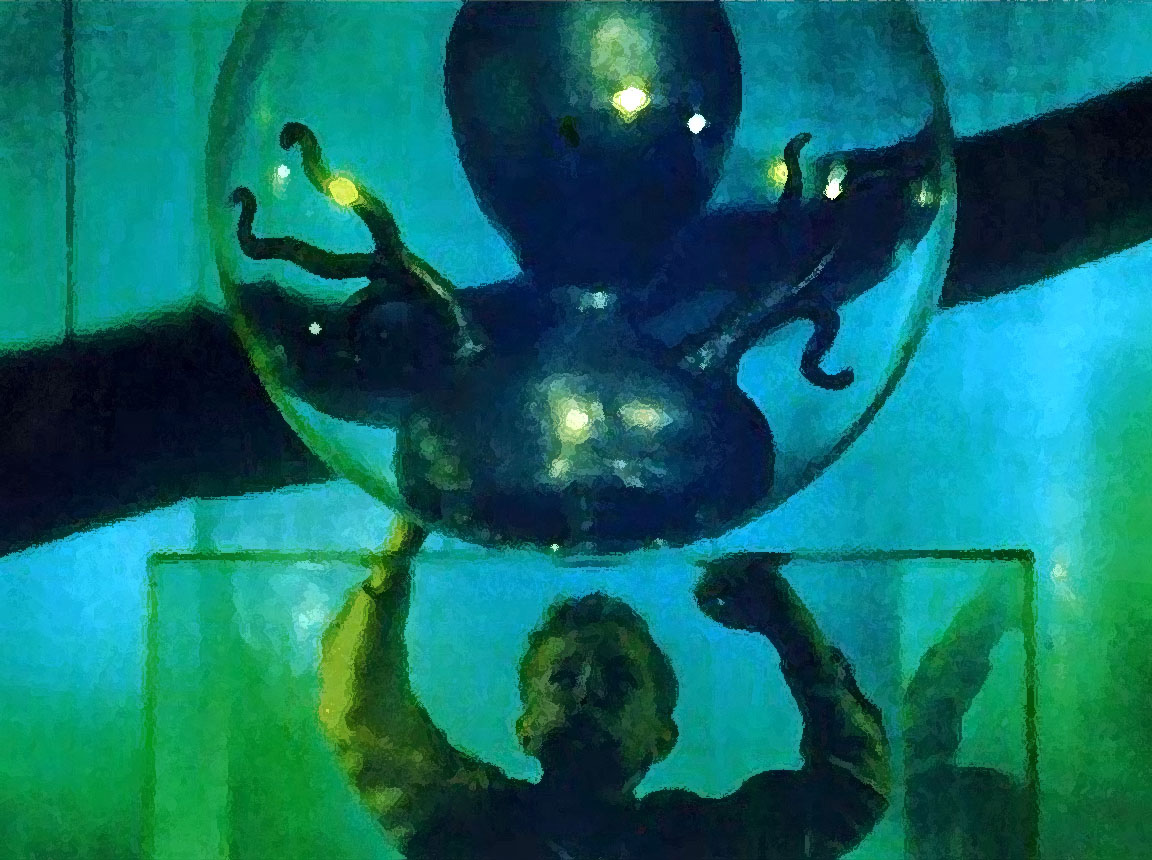
"Dr. Pat Blake" is placed upon the Martian operating table to have one of the devices inserted into her neck.
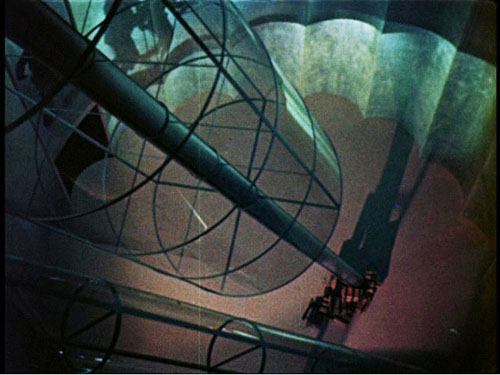
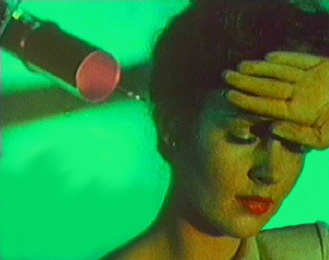
The military breaks into the tunnel system and meets the Martian humanoid troops with their Earth melting weapon.


"Colonel Fielding" and his troops rescue "David" and "Dr. Blake". They plant explosive charges within the flying saucer and on their way out are confronted with a dead end. "David" knowing how the melting gun works uses it to create an escape tunnel.

The flying saucer is taking off and they just make it to the surface. "David" begins to run from the rising saucer as the timer on the explosives reaches zero and a large explosion occurs. "David" jumps up in his bed and his parents enter to the screaming boy. Was this nothing more than an nightmare?
"David's" parents leave and he goes back to bed. Suddenly there's a sound outside and he looks out to see the flying saucer sinking into the Sand Pit.
"Invaders from Mars" can be viewed as simply a great gimmick ending Science Fiction motion picture, or, as some have suggested, a Freudian look at childhood. I hold to a subtle reflection of the fears caused in America by the "Red Scare". However, whichever you choose, or if you have another reason. It is fact that William Cameron Menzies ending upset British Censors.
The British Censors allegedly felt the nightmare ending would upset very young viewers. One has to understand that the film received an "X" rating that meant "Adults Only" and no persons under 16 was permitted to be sold a movie ticket.
However, changes were made to the ending sequence. The United Kingdom audience saw "David" join both "Dr. Blake" and "Dr. Kelston" behind a tank as the Martian saucer explodes in the sky. "Dr. Blake" assures "David" that his parents are now safe, because the Martian "Control Point" has been destroyed. The picture dissolves to the "MacLean" house where "Dr. Blake" and "Dr. Kelston", not his parents, put "David" to bed and the end titles appear.
At the time of the picture's British release the United Kingdom was in the middle of the Soviet Espionage case of Guy Burgess and Donald MacLean. Another major spy case at the time concerned George Blake within the British Embassy in West Berlin.
One month after the release of "Invaders from Mars" was a second Science Fiction that depending on your point of view dealt with the "Red Scare", or not.
IT CAME FROM OUTER SPACE released May 27, 1953

There was no question that this "Universal Picture" was in the Third-Dimension. Although that wasn't necessary to the "Red Scare" tone of this Science Fiction feature.
The motion picture was directed by Jack Arnold who became synonymous with 1950's Science Fiction. After "It Came from Outer Space", Arnold directed 1954's "The Creature from the Black Lagoon", 1955's "Revenge of the Creature" and "Tarantula". 1957's "The Incredible Shrinking Man" was Jack Arnold's last Science Fiction for Universal Pictures, but for other studios he directed 1958's "Space Children" and "Monster on the Campus".
The screenplay was based upon a double story treatment by Ray Bradbury. His first treatment was 37 pages and his complete story outline ran 119 pages. Neither was a short story called "The Meteor" as is sometimes reported. Actually, Bradbury than rewrote the treatments again with two variations of the aliens. One was with malicious aliens and the other with benign. In 2004 Ray Bradbury published all four versions of his story idea.
The screenplay, Bradbury had no input, was by Harry Essex. Essex first screenplay was 1941's "Man Made Monster" and then he took a five year break for World War Two. In 1946 he began to work on Film-Noir and in 1953 wrote the "The 49th Man". This was a "Red Scare" story about a nuclear readiness test by a fictional subversive attack by Communist agents. The test nuclear bombs grows by one and things turn into a real threat to the United States. The picture starred John Ireland and Richard Denning. Harry Essex's next screenplay was this picture and in 1954 he wrote "The Creature from the Black Lagoon".

The Main Cast:
Richard Carlson portrayed "John Putnam". Earlier in 1953 Carlson starred in the first of producer Ivan Tor's "Office of Scientific Investigation" trilogy, "The Magnetic Monster". After this film opened the actor starred in the 1953 3-D feature "The Maze". My article "Richard Carlson the Academic Turned Actor" can be found at:
http://www.bewaretheblog.com/2015/08/richard-carlson-academic-turned-actor.html

Barbara Rush portrayed "Ellen Fields". In 1951 Rush co-starred in producer George Pal's "Academy Award Special Effects" feature "When Worlds Collide". In 1954 she co-starred both with Rock Hudson in the 3-D "Taza, Son of Cochise" and with Tony Curtis and his wife Janet Leigh in "The Black Shield of Falworth".

Charles Drake portrayed "Sheriff Matt Warren". Drake had been acting since 1939. Almost every role he had prior to World War Two was non-on-screen credited because of their size. Although he did portray the bomber's navigator in director Howard Hawks' World War Two film "Air Force". After the war Charles Drake's roles increased in size and importance, but like many actors he drifted into television.


Joe Sawyer portrayed "Frank Daylon". To my generation Sawyer was "Sergeant Biff O'Hara" on television's "The Adventures of Rin-Tin-Tin". However, his early film appearances included 1936's "The Petrified Forest" with Leslie Howard, Bette Davis and Humphrey Bogart, director John Ford's 1940 version of John Steinbeck's "The Grapes of Wrath" starring Henry Fonda and 1946's "Gilda" starring Rita Hayworth and Glenn Ford.

This film is very controversial with the "Red Scare" concept, but that is partly due to the setting and the way the aliens are portrayed. Patricia Bosworth in her article "Flickering Movie Memories of a Daughter of a Blacklist", New York Times, September 27, 1992, take the position that the:
aliens from outer space serve as metaphors for the Soviet menace.

Bosworth's father was Attorney Bartley Crum. He was one of the six lawyers who defended the "HOLLYWOOD 10" in front of the "House Committee on Un-American Activities" in October 1947 the "Ten" refused to answer questions about their possible communist affiliations, spent time in prison for contempt of Congress, and afterwards were "Black Listed" by the American Motion Picture Industry and forced to leave the United States to find work. The "Hollywood Ten" included major Hollywood writers Ring Lardner, Jr. and Dalton Trumbo director Edward Dmytryk.
Above Bartley Crum in front of the "House Committee on Un-American Activities". Afterwards, the six defense lawyers faced disbarment and other problems attempting to make a living. On December 9, 1959, at the age of 59, Bartley Crum committed suicide by a combination of alcohol and barbiturates.
On the other side of the argument was Ray Bradbury who stated:
I wanted to treat the invaders as beings who were not dangerous, and that was very unusual.
"It Came from Outer Space" opens at the desert home of author and amateur astronomer "John Putnam". "Putnam" and his girlfriend, local school teacher, "Ellen Fields", are enjoying the Arizona night sky when they see what appears to be a meteor flash across the sky and in the distance impact the Earth.

The two get a local helicopter pilot to take them to the crash site and "Putnam" goes into the crater.
There he sees what appears to be a space craft -----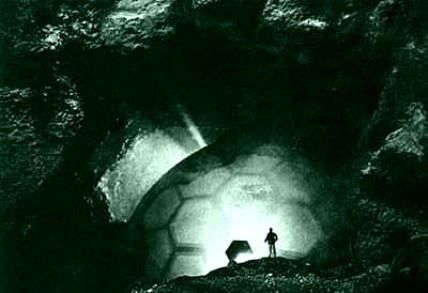
----the point of view switches to a bubble like form looking at "Putnaam" and then a land slide happens burying the craft.
"John Putnam" makes it to the top of the crater as cars from town are arriving. These include the local newspaper owner-reporter and the Sheriff.
"Putnam" is asked what he saw and everyone laughs him off talking about a space craft. 
Next strange things start to happen to the people of Sand Rock, Arizona.
Before I go further, the argument that "It Came from Outer Space" isn't about the "Red Scare" is based upon the location and size of the town. The argument claims that no Soviet agent would go into the 1953 Arizona desert to run an operation and especially in a small town without any government connection.
As Patricia Bosworth is claiming, the motion picture is not reality, but a metaphor of a Communist takeover of America. What could be more 1950's American than a small town of families who know each other, go to church together, send their children to the same one room school house, and share the same values?
Into this perfect Eisenhower community comes the invaders. Who want to destroy the perfect harmony, of Sand Rock, or do they?
To Ray Bradbury's comment, it should be remembered he wrote the story, but not the screenplay. Which would have set the tone of the feature. Bradbury also did not direct the actors, or decide upon the shots taken by cinematographer Clifford Stine. Who had been the camera man on both 1933's "King Kong" and "Son of Kong"among other films as the visual effects camera man.
"John" and "Ellen" are going back to his house from town and stop to speak to the two telephone line man and town electricians, "George" and "Frank".
They all hear a strange sound, but agree that the wind and weather conditions seem to cause such things. When "John" and "Ellen" leave it seems the sound is following them within the telephone lines. While, back with "George" and "Frank", they have finished their work and leave to return to town.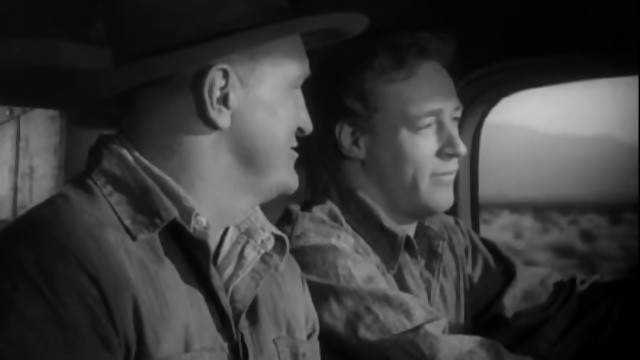
Then the first real meeting of the towns people and the aliens takes place. "George" gets out of the truck and a bubble like form appears and engulfs him in some kind of white substance. 
Later, "John" and "Ellen" return to the two linemen. They find what looks to be a sparkling dust that disappears in "John's" hands from the ground it was on. Next, the two see what appears to be a dead body behind a rock, but don't go over to see which of the lineman is lying there. "John" gets his gun from his car as "George" appears acting slightly different and somewhat emotionless. 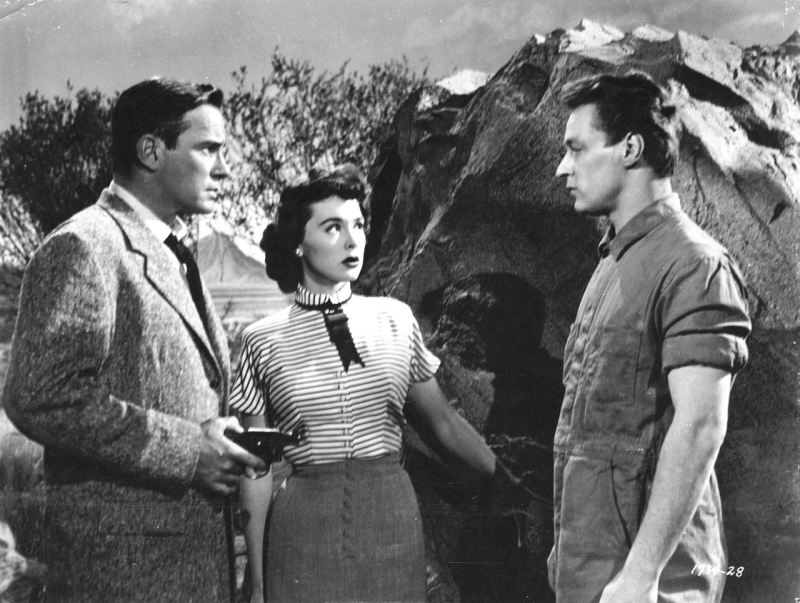
"Frank" is not around and "John" and "Ellen" believe the body is his. A comment is made of how hot it is and "George" looks directly into the sun without blinking. 
"Ellen" and "John" are told, by "George", that everything is all right and to leave. Thinking it's for the best not to push the issue. The two leave and head for Sand Rock and the Sheriff.
Next, "George" walks over to the body and it's himself. A little way away"Frank" regains consciousness and asks "George" what happened? As the other "George" also regains consciousness and the alien "George" tells the two there is nothing fear and they will not be harmed.
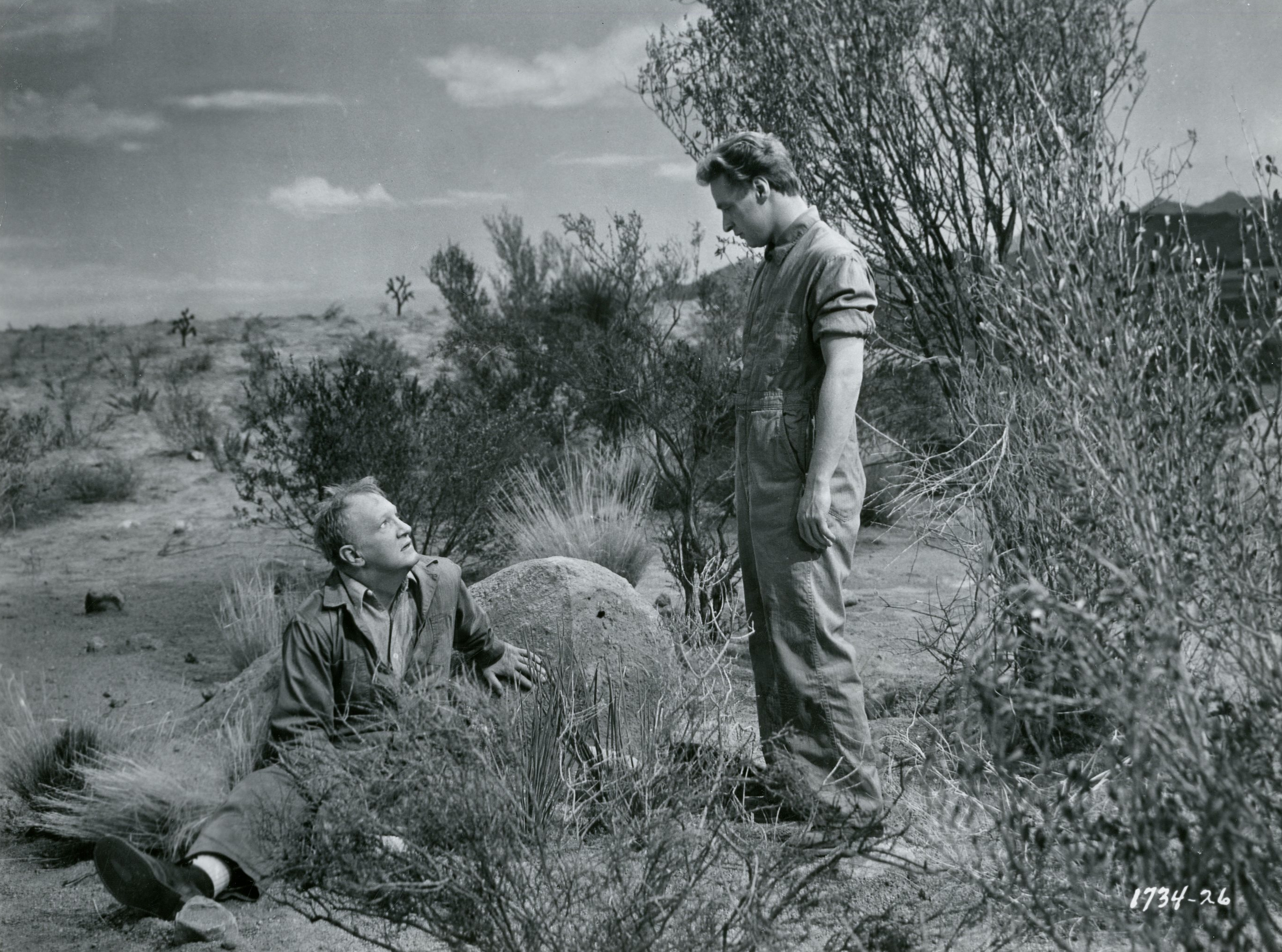
"Ellen" and "John" tell their story about the murder of "Frank" by "George" to the Sheriff. The Sheriff reluctantly goes with the two to the murder site, but there's no truck, or a dead "Frank". The Sheriff finds a dead coyote to explain the blood the two saw. Returning to town the two lineman walk down the street and the Sheriff thinks that "Ellen" and "John" have been out in the sun too long.
"John" decides to follow the two when he sees them again. 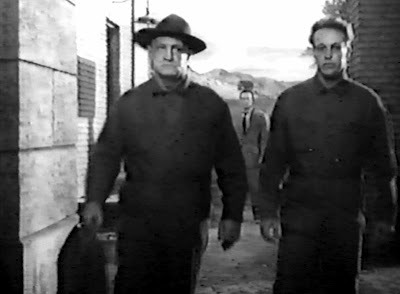
At the far end of the alley "John Putnam" confronts the aliens. He wants to know who, or what they are? They reply they mean no harm and have not hurt anyone. They ask "John Putnam" to let them go and for some reason he seems to trust the two aliens and does.
Out at the old "Excelsior Mine" three prospectors hear noises from the mine entrance and something comes out. That night "John" and "Ellen" have an encounter with one of the aliens, but then it disappears leaving a trail of the sparking dust that blows away in the night wind.
The following day "Frank's" wife and "George's" girlfriend go to the Sheriff and he calls "John" and "Ellen". The two women came to report they haven't seen either "Frank", or "George" for the last two days. The last time either women saw the two they were acting strangely. "Ellen" is asked to take them home and on her way back she encounters the alien "Frank" and is captured.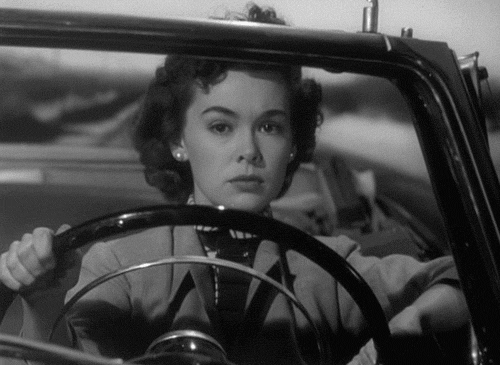
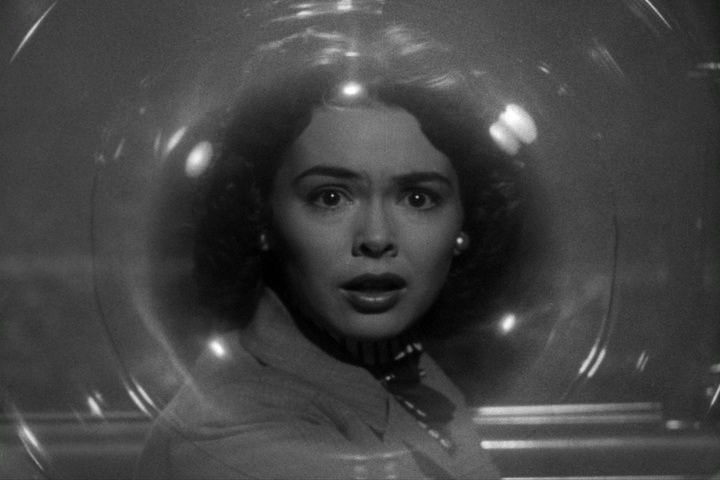
The Sheriff now has to face the fact that something is happening. The phone rings and it's a call for "John". After speaking to the person on the phone. He tells the Sheriff that "Ellen" has been taken. The two men go out to the desert near the Excelsior Mine and "John" tells the Sheriff he has to wait at the Sheriff's car as long as necessary. While "John" goes toward the mine and leans against a rock and spends the night waiting.
In the original 3-D release of this 80-minute motion picture. There was now an "Intermission".
"John" sees "Ellen" on the hill above the mine and then realizes it isn't her. 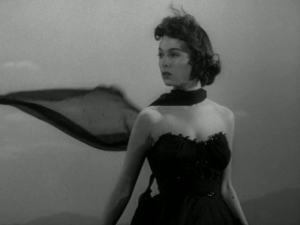

A voice calls and "John Putnam" stands at the entrance to the mine and calls into it. The alien commander doesn't want to reveal himself, because he believes his form will frighten the other. After "John" demands again, the alien agrees and comes out of the mine.


"John Putnam" learns that the aliens only came to Earth by an accident. There was a malfunction in there space craft and the aliens needed a way to repair the ship and obtain materials. So, the they substituted themselves for the local Sand Rock residents. None of them are hurt in any way and will be released shortly, before their ship takes off.
Returning to town, the Sheriff and "John" see the alien "Frank" walking on the street. The Sheriff wants to get him, but "Putnam" holds him off at gun point until he's sure the alien is safe. The Sheriff is through waiting and goes to round up a posse. While the Sheriff is gone "John" steals his car and heads for the mine.
This is a good point to discuss what the audience might have seen so far as it pertains to the "Red Scare".
Film critic A.H. Weiler in his review for "The New York Times", June 15, 1953, didn't like the picture, but may have hit upon a point he didn't consider in the anti-Communist vein of the period:
.... the adventure ... is merely mildly diverting, not stupendous. The space ship and its improbable crew, which keep the citizens of Sand Rock, Ariz., befuddled and terrified, should have the same effect on customers who are passionately devoted to king-sized flying saucers and gremlinsWeiler's comment about the terrified citizens of Sand Rock was looked upon, by the reviewer, in the context of a normal Science Fiction story. However, what is the motivation for that terror?
We have the rural American citizens of Sand Rock, Arizona, seeing their next door neighbors turned into emotionless people with an apparent subversive agenda. Which can be seen as very reflective of what American's were hearing and reading about Communist agents living next to them.
Once again, this is a rural setting in the middle of the Arizona desert and not a large American city, but the film has an allegorical tone to the story. Even, if Ray Bradbury doesn't see it in his original story line. The idea of the screenplay being an allegory does go to Patricia Bosworth's thinking, but seemingly not as it would pertain to her father's suicide from defending the "Hollywood 10".
"Frank" has left the town and the mob goes after him. Knowing the short cuts the mob gets ahead of the alien. As "Frank" sees the mob he starts to speed the truck up, but the mob opens fire and kills him.

The mob now heads for the mine.
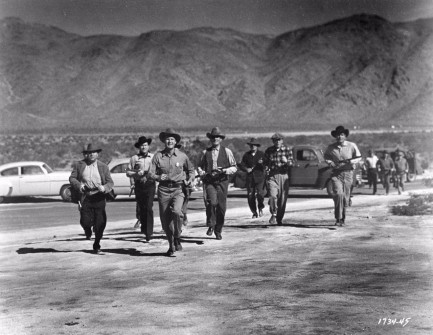
Meanwhile "John Putnam" arrives at the mine and encounters the alien "Ellen". Who attempts to kill him, but she is killed by "Putnam".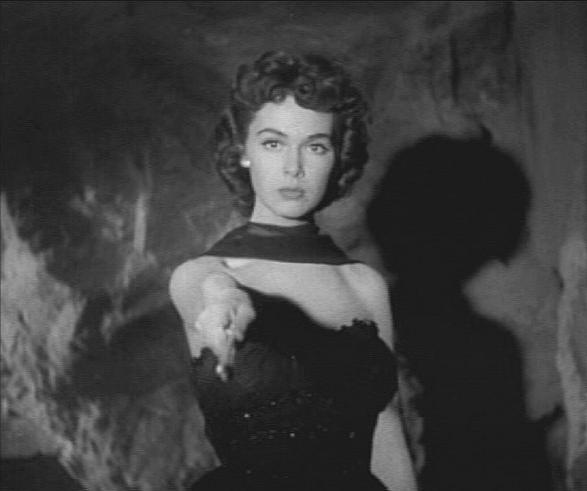
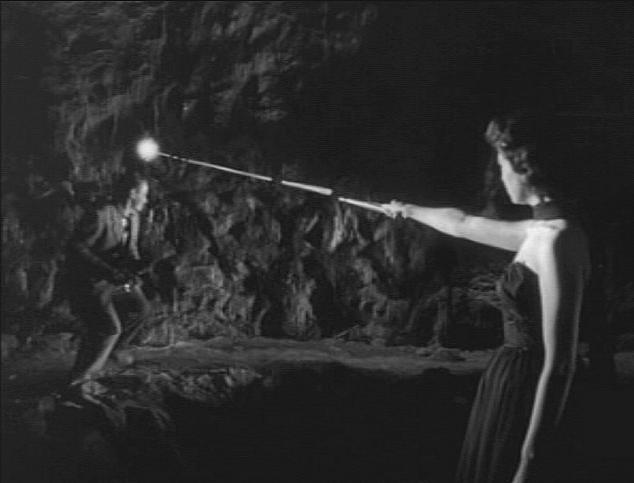
Going further into the mine he meets his own double, the alien commander. After a terse debate the alien commander puts his trust in "John Putnam", releases the towns people, and after exiting the mine. "Putnam" and the two prospectors seal it off preventing the mob from getting in.

After the alien craft leaves the Earth. "Ellen" asks "John" if their gone forever and he responds:
No, just for now. It wasn't the right time for us to meet. But there will be other nights, other stars for us to watch. They'll be back.
With the Korean War, as with Japanese-Americans after Pearl Harbor, Chinese-Americans became targets of the United States Government and in some case their own neighbors. There were incidents in San Francisco of groups of White-Americans attacking peaceful Chinese store owners and calling them Communists. Other such incidents including moves by the "Treasury Department" toward Chinese Businesses took place during the entire war.
Where the aliens of "It Came from Outer Space" a metaphor for Chinese Communists? Patrica Bosworth included the motion picture in her work about anti-Communist American propaganda during the Korean War era. The "American Film Institute" says the motion picture was nothing more than another Science Fiction film of the early 1950's. Others have both agreed and disagreed with Mrs. Bosworth. Watched during 1953 America the picture does have an allegorical aspect.
Which brings me to my third Science Fiction allegory of the McCarthy years and the "Red Scare":
INVASION OF THE BODY SNATCHERS released February 5, 1956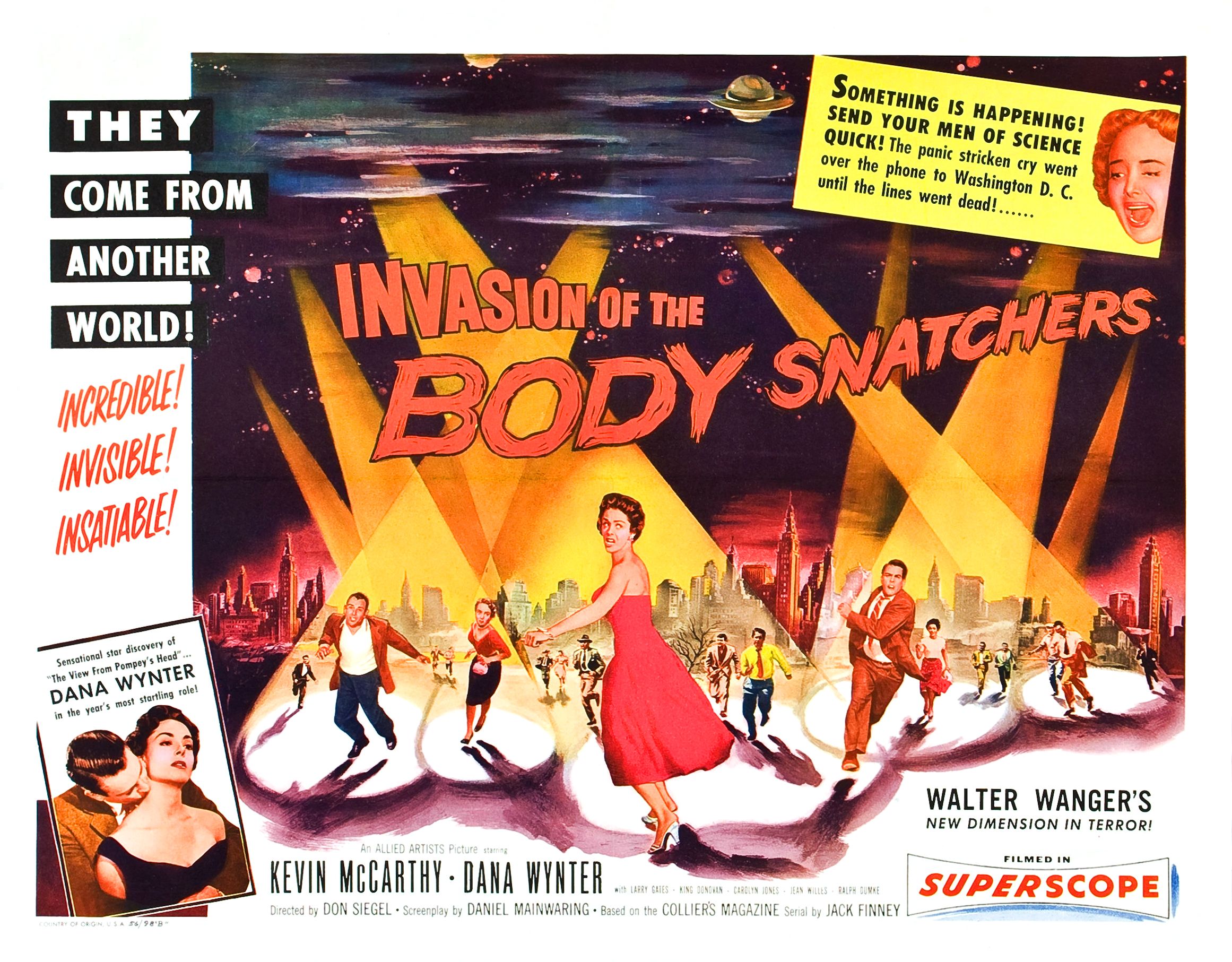
Above the American poster and below the United Kingdom poster._001.jpg)
"The Invasion of the Body Snatchers" was adapted from the 1955 novel "The Body Snatchers" by Jack Finney. The three major differences between the novel and the screenplay are with "The Body Snatchers".They only live for five Earth years,cannot reproduce and would leave a dead Earth as they have done on other planets. In the end they leave Earth for their own safety, because the humans are fighting back and it becomes too much of a problem for the invaders.
The motion picture was directed by Don Siegel. At that time, Siegel, whose directing would become synonymous with Clint Eastwood, 1968's "Coogan's Bluff", 1970's "Two Mules for Sister Sarah", 1971's "The Beguiled" and that years "Dirty Harry". Along with 1979's "Escape from Alcatraz" was still basically a television director.
The screenplay was written by Daniel Mainwaring. Mainwaring was "B" writer, but among his screenplays is the Robert Mitchum, Jane Deer and Kirk Douglas classic 1947 Film-Noir "Out of the Past". The overlooked and forgotten Western, 1949's "Roughshod", starring Robert Sterling, Gloria Grahame and John Ireland and the interesting, but also forgotten, 1946 "Swamp Fire". That starred two ex-Tarzan's, Johnny Weissmueller and Buster Crabbe.
The motion picture that 1956 audiences saw in the theaters. Was not the movie as shot and edited originally by director Don Siegel, or as written by Daniel Mainwaring.
The Four Mean Leads:
Kevin McCarthy portrayed "Dr. Miles J. Bennell". Over his on-screen career, including his final film released after his death. Kevin McCarthy appeared in 206 roles starting with a non-on-screen credited role in 1944's "Winged Victory". He followed that feature by switching mediums and appearing on a live 1949 broadcast on "The Ford Television Hour". Over the years McCarthy would alternate between both the television and motion picture mediums.
Dana Wynter portrayed "Becky Driscoll". Born Dagmar Winter in 1931 Berlin, Germany. Wynter's film career started in 1951 and for her first two years she was billed as Dagmar Wynter. Later. she would go star with Robert Taylor and Richard Todd in 1956's "D-Day the Sixth of June", co-star with Rock Hudson in 1957's "Something of Value" with 13th billed Sidney Poitier. Then co-star with Kenneth More in 1960's "Sink the Bismark!" and was part of the all-star cast of John Huston's 1963 "The List of Adrian Messenger".
King Donovan portrayed "Jack Belicec". Donovan was a character actor, but appeared in some interesting motion pictures. He was a "Reporter" in the classic 1949 fictional life of Louisiana's Governor Huey Long "All the King's Men" starring Oscar winner Broderick Crawford. In 1953 Donovan was "Dr. Dan Forbes" opposite Richard Carlson in Ivan Tors' "The Magnetic Monster" and "Dr. Ingersoll" in Ray Harryhausen's "The Beast from 20,000 Fathoms".
Carolyn Jones portrayed "Theodora 'Teddy' Belicec". Jones was Vincent Price's victim in 1954's 3-D "The House of Wax", Mickey Rooney's wife in 1957's "Baby Face Nelson" and of course "Morticia", from 1964 through 1966, on television's "The Addams Family". My article "THE ADDAMS FAMILY and THE MUNSTERS" may be read at:
http://www.bewaretheblog.com/2017/09/the-addams-family-and-munsters.html
Above in the foreground is King Donavan, behind left to right are Dana Wynter, Carolyn Jones and Kevin McCarthy.
Looking at the Screenplay:
I've mentioned that the released film was not the original one shot and edited by Don Siegel, or originally written by Daniel Mainwaring. The following is that original story line.
The film opens in the small rural farming community of Santa Mira, California. While not in a desert as in "It Came from Outer Space". This 1950's Eisenhower community is located in Central California and the people are as close to each others as the residents in Sand Rock, Arizona.
The fact that many film and political historians consider "Invasion of the Body Snatchers" an allegory of "Joseph McCarthy" and the "Red Scare" period. Should add credence to the previous Science Fiction film and Patrica Bosworth's points.
"Dr. Miles Bennell" has been seeing several of his regular patients and, strangely, all seem to be suffering from "Capgas delusion". Which is a delusion in which a family member believes another family member, close friend, or even a pet, has been replaced by an identical looking impostor.
Later, "Miles" meets his ex-girlfriend "Becky Driscoll". Who had returned to Santa Mira after a divorce. The two meet a police officer who mentions his wife doesn't seem like herself. 
After hearing this conversation, "Becky" mentions her cousin, "Wilma Lentz", played by Virginia Christine. Who is concerned about her "Uncle Ira", played by Tom Fadden, that she lives with. "Wilma" meets with "Dr. Brennell" and tells him how emotionless "Uncle Ira' is acting, but, then later, tells him there's no problem anymore. However, to "Milles", "Wilma", now appears emotionless.
"Miles" meets with "Dr. Dan Kauffman", played by Larry Gates, a psychiatrist, who assures him this seems like nothing more than a case of mass hysteria.
"Mass Hysteria" were buzz words in the 1950's and psychiatrists made a small living off of Americans, because of it. The hysteria, according to psychiatric journals, was actually attributed to both the "Red Scare" and "Senator Joseph McCarthy's" pushing his investigation into Communism. Playwright Arthur Miller classic play, "The Crucible", premiered on January 22, 1953. Miller used the "Salem Witch Trials" as a background for his allegorical attack on McCarthy and the mass hysteria being caused at the time.
On April 22, 1954, Americans through the medium of television, on the forgotten "DuMont Network", watched enthralled, gavel to gavel, the downfall of Joseph McCarthy. Who was defended by his attorney Roy Cohn in the "Army-McCarthy Hearings" lasting through June 17, 1954.
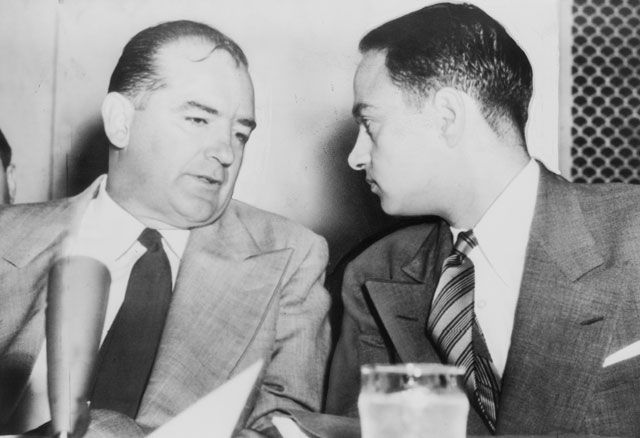
Above on the left Senator Joseph McCarthy and on the right Attorney Roy Cohn.
On December 2, 1954 in a 67 to 22 vote, Senator Joseph McCarthy was censured by Congress, but he remained in the Senate for another two and half years until May 2, 1957.
In the evening "Dr. Bennell's" friend "Jack Belicec" calls him and wants "Miles" to come over immediately. "Jack" takes the other man to his basement and shows him a body with his own features on it, but not quite a complete copy. Neither man knows what it is, or where it came from. Later, "Becky" calls "Miles" in panic as she has a duplicate of herself in her basement. "Miles" calls "Dan Kauffman" to come over to "Becky's". When they go to the basement the body's gone. The three now go to the "Belicec's" and make the same discovery. "Dr. Kauffman" tells "Dr. Bennell" that he is suffering from the same "Mass Hysteria" affecting Santa Mira.
The following night "Miles", "Becky", "Jack" and his wife "Teddy" find duplicate bodies coming out of seed pods in "Dr. Bennell's" greenhouse.


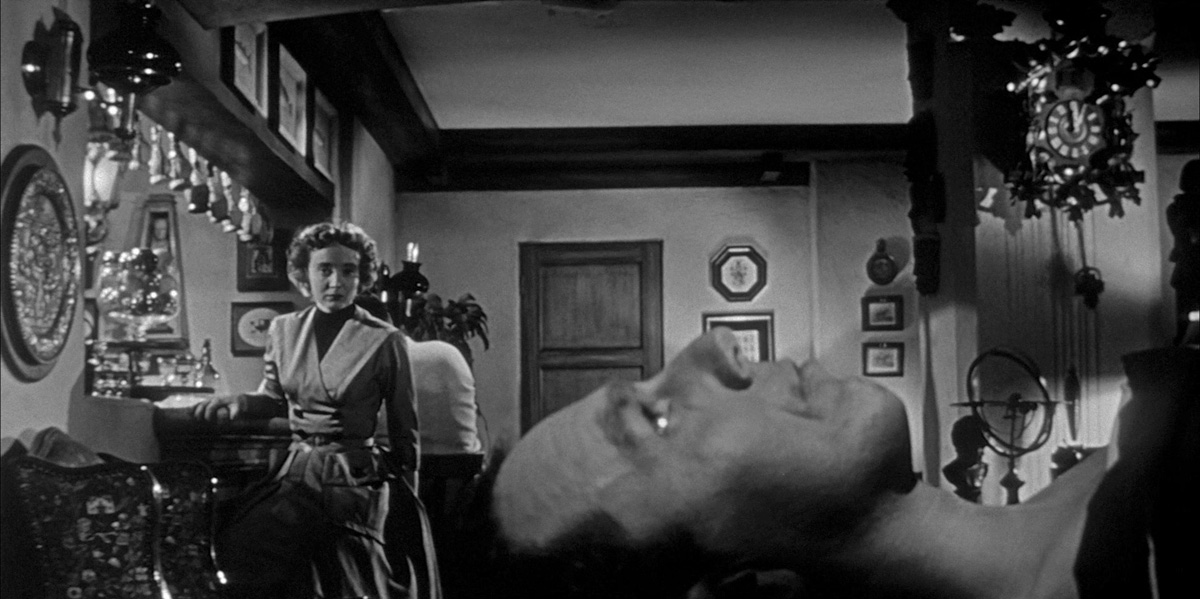
The group concludes that the people of San Mira are being replaced by duplicates as they sleep. "Miles" attempts to make a long distance call to get help from the military, but the operator, in an emotionless voice, tells him all the lines are both dead and busy at the same time. "Jack" and "Teddy" drive off to seek help in the next town.
The following morning "Miles" and "Becky" watching through a window of his office. View farm trucks arriving not with produce, but giant seed pods.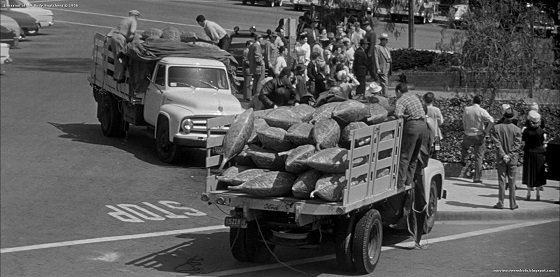
"Dr. Dan Kauffman", "Jack Belicec" and "Chief of Police Nick Grivett", played by Ralph Dumke, arrive at "Dr. Bennell's" office. They are duplicates and reveal that the seed pods are an extraterrestrial life form. That can duplicate any form of life and have traveled through space and come to the Earth at Santa Mira.
It's from 1956's "Invasion of the Body Snatchers" that the term "Pod People" originally came. At the time, the term referred to people within the Soviet Union's sphere of influence. Who obey, without apparent question, their Communist leadership and appeared to 1950's Americans, through United States government propaganda, as emotionless shells.
The argument made by the "Pod" version of "Dr. Kauffman" is that humanity will lose all sense of emotions and individuality and create a simplistic, stress-less world.
According to the "Encyclopedia Britannica":
Some of what Joseph Stalin wanted was a Soviet revolution "devoid of ideological sentiment", "a monolithic party", "a classless society", with a centralized government in control of the people.
https://www.britannica.com/topic/Stalinism
A scuffle between "Miles" and the three "Pod People" takes place and "Miles" is able to knock the others out. accompanied by "Becky" the two escape into the streets of Santa Mira. Outside the two pose as "Pod People" until "Becky' sees a dog almost hit be a dog and screams. An alarm is sounded and the two are now pursued by a mob made up of other Santa Mira residents.
The two get to "Miles'" car and drive into the countryside. They stop at a gas station and later discover two seed pods in the truck.



"Miles" and "Becky" make it to an abandoned mine and very exhausted go inside to hide from the "Pod People".

"Miles" hears music and leaves "Becky" to see where it's coming from. He observes a large farm growing the seed pods and trucks leaving. Returning to "Becky", he kisses her, and realizes she isn't "Becky" anymore.
"Pod People Becky" now sounds the alarm and near-by other "Pod People" start to converge, but "Miles" is able to escape to the highway. There he attempts to wave a car down and sees a truck filled with seed pods. "Miles" frantically runs away screaming at the on-coming vehicles:
They're here already! You're next! You're next!
At least that was the way Don Siegel and Daniel Mainwaring wanted the picture to be.
After the screening of the film for producer Walter Wanger. Whose films included the Marx Brothers 1929 "The Coconuts", John Ford's 1939 "Stagecoach", Alfred Hitchcock's 1940 "Foreign Correspondent" and Ingrid Bergman's 1948 "Joan of Arc".
Wanger told Don Siegel that felt the movie was too pessimistic as edited. To protect the picture from extensive cuts by "Allied Artists" executives who had seen the picture with him. Wanger paid for new actors to appear in both a prologue and epilogue.
Enter non-on-screen credited Whit Bissell as "Dr. Hill". Bissell had been "Bob Ford" in 1951's "The Great Missouri Raid", "Stanley Briggs" in 1951's "The Lost Continent" and "Dr. Edwin Thompson" in 1954's "The Creature from the Black Lagoon".
Non-on-screen credited Richard Deacon as "Dr. Bassett". Deacon was also a non-on-screen credited "MP" in 1953's "Invaders from Mars", a "Bald Reporter" in 1954's "THEM!" and a "Pilot" in 1955's "This Island Earth".
Above Richard Deacon, Kevin McCarthy and Whit Bissell in the prologue.
The prologue has "Dr. Hill" called to the emergency room of a California hospital that has a screaming man in it. He agrees to listen to the man's story and emergency room "Dr. Bassett" is also present. A flashback now starts of "Dr. Bennell" in the peaceful community of Santa Mira.
The epilogue begins at the end of the flashback of 'Mile's" screaming in the road. "Dr. Hill" believes the man is psychotic and leaves the hospital room as an injured man is being wheeled into the emergency room. This is a truck driver that was involved in an accident and the orderly mentions that they had to dig him out from under a pile of giant seed pods. "Dr. Hill" now calls the FBI as the movie fades out.
These films reflect the world I spent my first ten years in and many years to follow into the Vietnam War.

